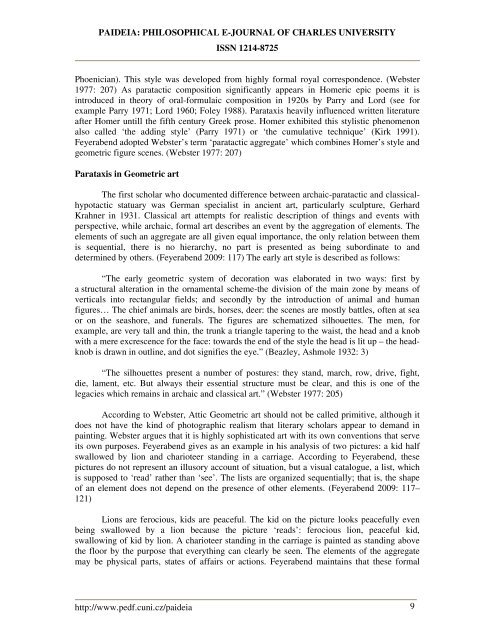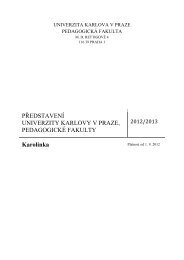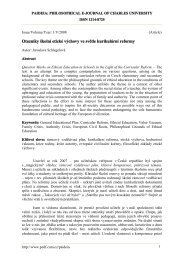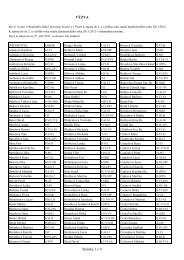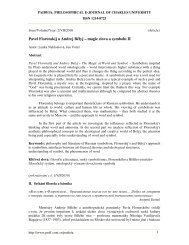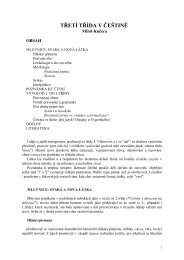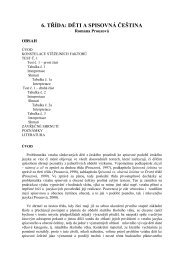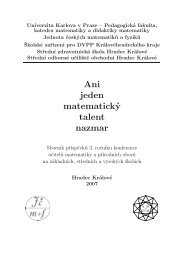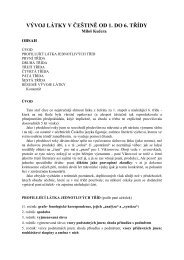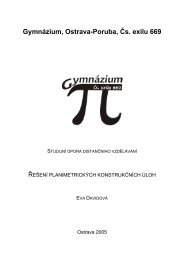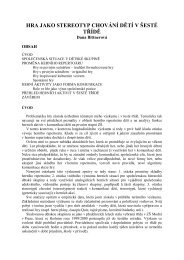Feyerabend's interpretation of Archaic Age
Feyerabend's interpretation of Archaic Age
Feyerabend's interpretation of Archaic Age
You also want an ePaper? Increase the reach of your titles
YUMPU automatically turns print PDFs into web optimized ePapers that Google loves.
PAIDEIA: PHILOSOPHICAL E-JOURNAL OF CHARLES UNIVERSITYISSN 1214-8725Phoenician). This style was developed from highly formal royal correspondence. (Webster1977: 207) As paratactic composition significantly appears in Homeric epic poems it isintroduced in theory <strong>of</strong> oral-formulaic composition in 1920s by Parry and Lord (see forexample Parry 1971; Lord 1960; Foley 1988). Parataxis heavily influenced written literatureafter Homer untill the fifth century Greek prose. Homer exhibited this stylistic phenomenonalso called ‘the adding style’ (Parry 1971) or ‘the cumulative technique’ (Kirk 1991).Feyerabend adopted Webster’s term ‘paratactic aggregate’ which combines Homer’s style andgeometric figure scenes. (Webster 1977: 207)Parataxis in Geometric artThe first scholar who documented difference between archaic-paratactic and classicalhypotacticstatuary was German specialist in ancient art, particularly sculpture, GerhardKrahner in 1931. Classical art attempts for realistic description <strong>of</strong> things and events withperspective, while archaic, formal art describes an event by the aggregation <strong>of</strong> elements. Theelements <strong>of</strong> such an aggregate are all given equal importance, the only relation between themis sequential, there is no hierarchy, no part is presented as being subordinate to anddetermined by others. (Feyerabend 2009: 117) The early art style is described as follows:“The early geometric system <strong>of</strong> decoration was elaborated in two ways: first bya structural alteration in the ornamental scheme-the division <strong>of</strong> the main zone by means <strong>of</strong>verticals into rectangular fields; and secondly by the introduction <strong>of</strong> animal and humanfigures… The chief animals are birds, horses, deer: the scenes are mostly battles, <strong>of</strong>ten at seaor on the seashore, and funerals. The figures are schematized silhouettes. The men, forexample, are very tall and thin, the trunk a triangle tapering to the waist, the head and a knobwith a mere excrescence for the face: towards the end <strong>of</strong> the style the head is lit up – the headknobis drawn in outline, and dot signifies the eye.” (Beazley, Ashmole 1932: 3)“The silhouettes present a number <strong>of</strong> postures: they stand, march, row, drive, fight,die, lament, etc. But always their essential structure must be clear, and this is one <strong>of</strong> thelegacies which remains in archaic and classical art.” (Webster 1977: 205)According to Webster, Attic Geometric art should not be called primitive, although itdoes not have the kind <strong>of</strong> photographic realism that literary scholars appear to demand inpainting. Webster argues that it is highly sophisticated art with its own conventions that serveits own purposes. Feyerabend gives as an example in his analysis <strong>of</strong> two pictures: a kid halfswallowed by lion and charioteer standing in a carriage. According to Feyerabend, thesepictures do not represent an illusory account <strong>of</strong> situation, but a visual catalogue, a list, whichis supposed to ‘read’ rather than ‘see’. The lists are organized sequentially; that is, the shape<strong>of</strong> an element does not depend on the presence <strong>of</strong> other elements. (Feyerabend 2009: 117–121)Lions are ferocious, kids are peaceful. The kid on the picture looks peacefully evenbeing swallowed by a lion because the picture ‘reads’: ferocious lion, peaceful kid,swallowing <strong>of</strong> kid by lion. A charioteer standing in the carriage is painted as standing abovethe floor by the purpose that everything can clearly be seen. The elements <strong>of</strong> the aggregatemay be physical parts, states <strong>of</strong> affairs or actions. Feyerabend maintains that these formalhttp://www.pedf.cuni.cz/paideia 9


